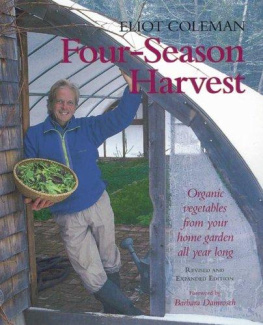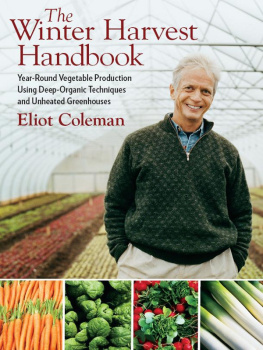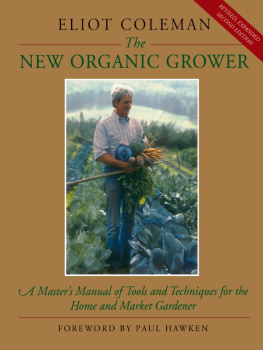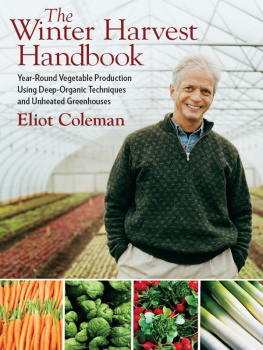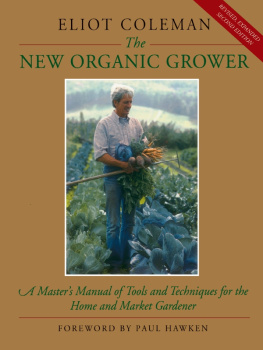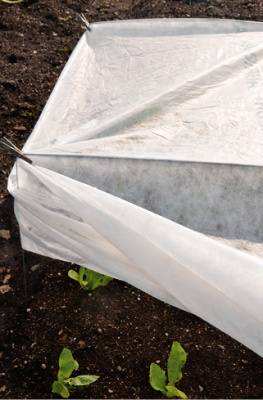Table of Contents
GARDENERS SUPPLY BOOKS
Eliot Coleman, The New Organic Grower: A Masters Manual of Tools and Techniques
for the Home and Market Gardener
Leandre Poisson and GretchenVogel Poisson, Solar Gardening: Growing Vegetables
Year-Round the American Intensive Way
Lynn Byczynski, The Flower Farmer: An Organic Growers Guide
to Raising and Selling Cut Flowers
Katherine LaLibert and Ben Watson, Passport To Gardening:
A Sourcebook for the 21st-Century Gardener
Shep Ogden, Straight-Ahead Organic: A Step-by-Step Guide
to Growing Great Vegetables in a Less than Perfect World
Eliot Coleman, Four-Season Harvest: How to Harvest Fresh Organic Vegetables from
Your Home Garden All Year Long, revised edition
GARDENERS SUPPLY COMPANY was founded in 1983 in Burlington, Vermont, to make available innovative tools and equipment that would bring the joys and rewards of gardening to as many people as possible. Gardeners Supply serves gardeners of all interests and abilities with seasonal catalogs that offer earth-friendly methods for growing plants in all climate zones and seasons. Seasonal specialty catalogs, a retail store and the renowned community and demonstration gardens in Burlingtons Intervale, and a complete line of high-performance home greenhouses combine to make Gardeners Supply Americas Gardening Resource.
To further its mission as the leading source of new ideas and information for gardeners, Gardeners Supply has joined Chelsea Green Publishing Company to co-create and co-publish a series of gardening books.The books in this series are written by pioneering individuals who have firsthand experience in using innovative, ecological techniques to grow healthy food and flowers that enhance our livesand the well-being of Earth.
Stephen Morris
Will Raap
President, Chelsea Green
President, Gardeners Supply
Text copyright 1992, 1999 Eliot Coleman. All rights reserved.
Illustrations copyright 1992, 1999 Kathy Bray. All rights reserved.
Unless otherwise noted, photographs copyright 1999, Barbara Damrosch. All rights reserved.
Designed by Ann Aspell.
No part of this book may be transmitted or reproduced in any form by any means without permission in writing from the publisher. Send written requests for reprint permissions to Chelsea Green Publishing Company, P.O. Box 428, White River Junction, VT 05001, or send a fax to (802) 295-6444.
Printed in the United States of America.
030201 345
First printing, September 1999
Library of Congress Cataloguing-in-Publication Data
Coleman, Eliot, 1938-
Four-season harvest: how to harvest fresh organic vegetables from your home garden all
year long / Eliot Coleman; illustrations by Kathy Bray; and photographs by Barbara
Damrosch.Rev. ed of: The new organic growers four-season harvest. c1992.
p. cm.
Includes bibliographical references (p. ) and index.
ISBN 1-890132-27-6
1. Vegetable gardening. 2. Organic gardening. I. Title.
II. Title: Four-season harvest.
SB324.3.C64 1999
635.0484dc21 99013209
CHELSEA GREEN PUBLISHING COMPANY
P.O. Box 428
White River Junction, Vermont 05001
telephone (800) 639-4099
www.chelseagreen.com
To Ian, Clara, and Melissa, who enjoy good food.
FOREWORD
ITS HARD TO ACHIEVE anything new in an endeavor as old as gardening, but Eliot Coleman has done it. After years of experimentation, he has rein-vented the gardening year. The old seasons, and the iconography by which we know them, may soon be folklore.
Spring: A mischievous sprite, a warm breeze that moved housebound gardeners out of doors to happily waste themselves, despite whatever mercurial weather tested their commitment. Summer: A Rubenesque goddess who swelled the garden with far more bounty than anyone could tend, let alone eat, even with the help of rabbits and bugs. Fall: A scolding harpy who recited gardeners failures to them as they picked their way through weeds and sprawling vines to glean tomatoes and squash before the apocalypse of frost. Winter: A wraith who hovered over what was once the garden, whispering, Gone, gone.... Return to your VCR and supermarket vegetables.
Imagine, instead, a scenario in which spring work begins more gradually, summer spares time for other outdoor pleasures, fall is a gearing-up rather than a giving-up, and winter, best of all, is a time to reap a fresh harvest with almost no work. For most of us, eating out of the garden is a short seasonal pleasure, unless we live in a very warm place or can afford a heated greenhouse, and the canning-freezing-drying scramble never quite compensates for summers loss.
The Four-Season Harvest presents a way to eat the best foodgarden-fresh and chemical-free-all year long, with little effort or expense. Most dedicated gardeners know some season-extending techniques, but this book is not merely about season extension. Its about gardening and eating in a manner appropriate to each season.
I first learned something of Eliots gardening methods through his first book, The New Organic Grower. It was refreshing to read someone for whom gardening is not a gladiatorial contest. Eliot makes nature his ally. Because his approach is biological, he focuses on plants and soil rather than high-tech structures. His tools are simple, refined to simpler, perfected as simplest.
Being a simpler-is-better sort of person myself, I was curious to see what Eliot was doing in his own garden, so on a trip to Maine to see my family, I paid him a visit. What I saw was a splendid, productive gardenthe end result of twenty-five years of tinkering. Eliots techniques may have been derived from age-old practices, but they had been customized and updated with modern know-how and, occasionally, modern materials. Nothing there was faddish. Just good, logical stuff: a more efficient cold frame; compost made in straw bale containers; subtly redesigned hand tools.
When I questioned Eliot it was obvious that his garden was not the result of his knowledge, but vice versa. He had paid attention to natural systems and they had taught him how to work with nature. This experience gave him enormous confidence in the natural worldthe very thing so many gardeners seem to lack.
It became clear to me that Eliots approach made his life a lot easier. I could see this in the project that was consuming him at the time: the practice of a year-round harvest which he shares in this book. Instead of trying to prolong his summer harvest, Eliot was growing a wide range of cold-tolerant crops (including some Id never heard of) and then giving them the minimum protection they needed. He was doing this by taking the best cold-protection devices, modifying and recombining them into a system that enabled him to eat homegrown vegetables each day, a system that was inexpensive, easy to maintain, and fun.
Eliots garden was a beckoning sort of place and he seemed to take constant delight in everything he did there. No wonder he wanted a garden that was in all the time, not just half the year.
I left Maine that summer with all sorts of good ideas, eager to try some of them in my Connecticut garden. That never happened. Soon after our meeting, I moved to Maine, and within a year Eliot and I were married. His garden is now our garden, though I am only vice president when it comes to the vegetables (he is vice president of the flowers). I can now attest to the joy and ease of eating a fresh, healthy, year-round harvest.

